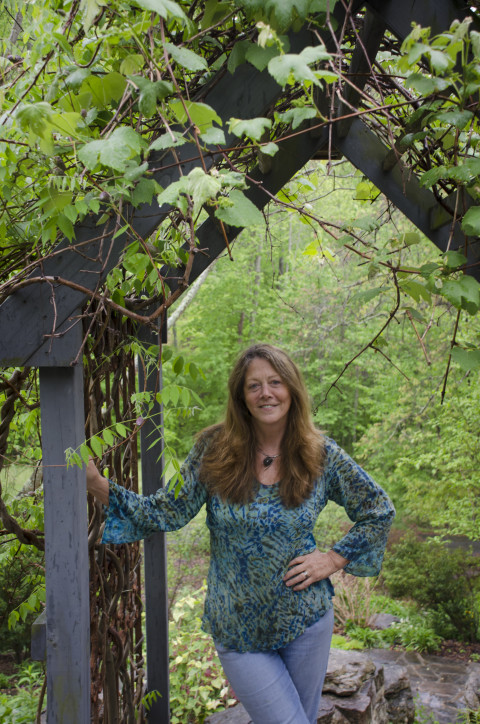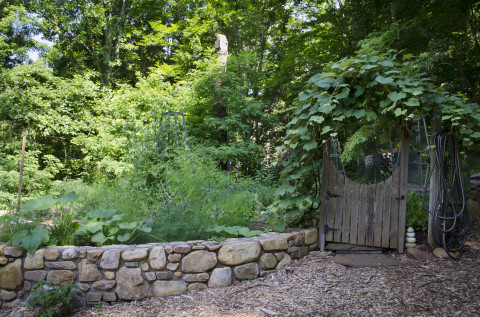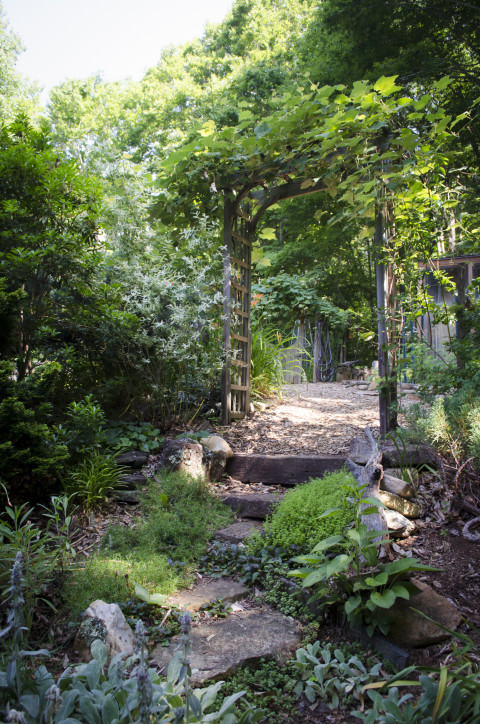
For many, edible plants are grown in rows in the vegetable garden — often kept out of sight in the back or side yard. But for Sheila Dunn, a retired microbiologist and Master Gardener, edibles are a practical and beautiful necessity to be displayed and woven into the landscape. Dunn converted her steep, rocky Weaverville property into an edible landscape filled with fruits, vegetables, nuts, herbs, mushrooms and bees.
Mountain Xpress: How did you become interested in growing edibles?
Dunn: The main impetus was that I’m a foodie, and I’m also very thrifty. When I saw Asian persimmons at the store for $2.69 a piece — and they’re my favorite — I just said, “I’m not paying this, especially for something that’s been shipped from who knows where in Styrofoam. There’s got to be a smarter way.”
I like to eat exotic food and things I can’t find around here, so now I grow it. I even grow oranges, coffee and lemons indoors — not at a high-volume, but enough that I’m helping to cut down on the cost to ship and package produce. I also grow sources of protein, like shiitake mushrooms and hazelnuts.
Altogether, I grow about 60 percent of what I eat, and I share the rest with friends. And some food bartering helps too. There’s a lot of homesteaders and little farms near here, so they have eggs and meat to share with me.
That said, I started this to save money, but that was the craziest idea I’ve ever had in my life. I call it the $64 raspberry. By time you’ve made compost, hauled it up the hill, composted, watered, beat the raccoons and the squirrels to it — you haven’t saved a penny, truly. So my initial premise was a little wrong, but I did want to be sustainable. I wanted this place to have the right combination of food so I could live off it, if I had to.
Can you explain the difference between edible landscaping and edible gardening?
A typical garden for edibles is done in rows, whereas I’ve got edibles tucked in everywhere. This place is about 60 percent covered in edibles, mixed with perennials and pollinators. My strategy is to create really windy paths around the property, lined with fruit trees and fruit bushes. It makes your property seem five times bigger because it takes that much longer to walk it when you’re winding around. The bushes obscure your view and create curves, so around each bend there’s something new to see.

Even my veggie garden, I do in circular patterns. I think it’s more aesthetically pleasing, but it also seems to fool the predators. Bugs will go right after a big, long row of something, but when things are sprinkled around, you have a higher success rate, even if it does make it harder to harvest.
With edible landscaping, you’re moving toward letting the property take care of itself. I realized a couple of years ago I was spending 40 hours a week on this property — and that’s a full time job. I’m retired, but still, I have other things I want to do besides weed.
Ninety percent of this is hard, back-breaking work, and I’m just one person. So eventually I’m working toward having it be things that take care of themselves easily. Examples of that are plants like hardy kiwis and jujubes.
That said, I do have some stuff growing in rows in an area of reclaimed woods. I have a whole lot of vegetables there — 25 tomato plants, Brussels sprouts, kale, a zillion herbs, about 500 strawberries, hazelnuts, mulberries. But that area is in transition, and eventually it will become a self-sustaining orchard.
When you choose what to grow, do you go with what grows easily or what you most want to eat?
My criteria are this: Do I love it? Is it expensive at the grocery store? Is it something that I can’t find at the grocery store? I also don’t grow anything that requires constant pruning or bug-picking. I don’t baby anything.
I made a lot of mistakes my first few years planting things that were pretty, but I don’t love them. Like okra, which is a beautiful plant, but I don’t use it very often. But I think it’s worth growing something if it has to be shipped from far away. I experiment every year with growing something new and weird. Like quinoa. Or the Chinese jujubes. Those are small trees, but the fruit is amazing. You dry them and they’re like dates. They can withstand drought, they can withstand floods, they never, ever have a pest, and they bloom and produce every year. Same with hazelnuts; they’re no-brainers.
The quinoa, by the way, didn’t do so well. But I have grown some Andean stuff like yacón and it was very successful.

For people who are interested in growing edibles, what are some tips you would recommend?
The first thing for me was to get rid of the lawn. When I moved to this house, it was 100 percent pure-clay lawn, surrounded by woods. I lost control of an electric mower that I was running at about a 60-degree angle. It fell down the hill, still going, and I said, “I’ve had it with this.” That’s when I decided to terrace the front and put in paths, but it is a process. Just this year, I’ve replaced the last of the grass and I finally gave away my mowers last year.
The hardscaping is where the expense comes in. I chose stone terraces, but that’s expensive. You can use timber, but for organic gardening you can’t use treated wood. You can also think about going vertical with trellis gardening. You can grow hops, muscadines, hardy kiwis, luffa gourds, squashes, peas, any kind of trailing plant. Seedless grapes can be a little difficult here, but you can grow Concords easily. You can fit an amazing amount of crops in an area about the size of a deck.
I don’t grow purely natives, but some people do that, and there are many edible natives, like elderberry, sochan and nettles. You do have to watch out for aggressive plants. Many people think only non-natives can be invasive, but some — Jerusalem artichokes and native mints for example — are very aggressive, and so you want to keep those in containers.
I think the average homeowner would just get a kick out of growing edibles. Let’s say you have a place you’re going to put in a bush. Well, instead of putting in an exotic flowering bush, why not put a blueberry bush or a cherry bush? You can make a smoothie or a pie and know that it doesn’t have pesticides on it, and it will taste better because it’s right off the plant. Plus you can freeze the excess and have smoothies every day, even in the winter. In the same way, if you have a little area and you know you’re going to grow a tree in it, why not grow an Asian persimmon or an Asian pear or a jujube or a cherry?
It’s much more fun than growing petunias. There’s a lot of really cool things you could do, and then you’ve got the satisfaction of going out there and harvesting your own fruits. You can work in phases and depending on what you do, it doesn’t have to be that much work.
Scroll through the slideshow to see more from Sheila Dunn’s Weaverville garden. Photos by Carrie Eidson.




I was lucky to have met Sheila once and seen her garden — which was the most incredible, inspiring, beautiful garden space I have ever seen. Thanks Carrie for a great article about this fascinating woman and her edible landscape. I wish all gardeners could see what Sheila has done to her hillside property. It’s totally amazing.
Marcianne Miller
Sheila forgot to mention me. It was my idea to do the edible landscaping. I had to talk her into it. The 2 of us spent years digging and planting. I spent months digging trenches and laying pipe for almost 2 acres of drip irrigation. Hundreds of zones! I built the green house also. I don’t know why she left me out?
Ouch. I can’t speak for Sheila. Perhaps she was so into the wonder of the way her paradise was at the moments I was there that she didn’t think about its history. I hope you will let us know more about you and what you do so that anyone who can use your expertise knows how to reach you! thanks. mm
Hi, meet Sheila Dunn through an aquatintance. So a group of friends and other Master Gardeners meet at her home and we received a lovely tour of her gardens. It has been many years that have gone by and I have not heard of anything news of Sheila. Perhaps, you can inquire and let her know that I still think of her and her wonderful garden and superior knowledge of gardening.
Sincerely, Diana Gricus at dgricus@bellsouth.net
Hi, I have a steep hill that we are landscaping. My goal is to keep it natural looking and use edible plants….after searching for photos on google for ideas- I came across this article. This is EXACTLY what I’m looking for! I would love to get in touch with Sheila- even just to have her label her plants on the photos you posted. Please forward my information…I would be so appreciative!!
Thank you,
-Emily Turgeon